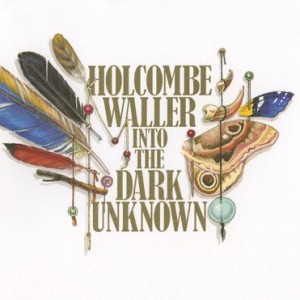
A question: Who is Holcombe Waller?
1. Holcombe Waller is a singer.
And he sings with a voice that initially recalls the modern times folk register of our men of the Pacific Northwest (Colin Meloy, Ben Gibbard, and especially Jon Auer), similarities that hold until Waller’s scary commitment makes you question the aptitude of comparing voices. A singer uses the voice he was given; a brave one lets it rattle all the atoms in his body, giving their echoed image to the listener. Those other men are mere musicians (great ones); Waller was born cursed to sing his way through this world.
2. Holcombe Waller is other people.
The curse persists on Into the Dark Unknown, a new collection of twelve songs culled from a theatrical folk concert first staged in 2009. But the songs, all interiority and bed-ridden body-pondering, rarely suggest a dramatic component, and cohere without it, although the interiority does often seem to belong to characters and not specifically to Waller, as he throws his first-person into nearby ghostly vessels. “Atlas” opens the album in a mode of character sketch—“he’s going back on the drugs,” we learn, while the controlled shakiness of Waller’s voice tells us what that means—but it doesn’t set the pace; elsewhere the songs are so thoroughly stripped down to the physical that the subjects could be anyone.
3. Holcombe Waller is heartbreakingly human.
Muddled in the plans
To be a woman or a man
“Shallow” opens with these words, but throughout the album, Waller overcomes the muddle without sacrificing either option. He accesses the rolling, shifting rhythms of Tori Amos on “The Unicorn,” most eerily at the moment the vocal melody almost interrupts itself with a series of quickening, rising notes that are also the sound of falling, laid atop lulling, sleepless piano. At other times the album proves a perfect companion, or flipside, to the matrimonial bliss of Patrick Wolf’s new Lupercalia, the lonely, naked R&B of How to Dress Well’s Love Remains (“my body’s waiting…”), and The Hidden Cameras’ symphonies of male bodies. Sometimes all three (and their dominant qualities of love, loneliness and lust, respectively) register at once, when a song’s emotional space extends all the way to the farthest reaches of skin in the narrator’s vision, when both solace and solitude are found in the proximity of a lover. The imagery is non-theatrical, except in the sense that it’s so tightly bounded: Waller sings about being the “soft curve in your hard line,” tells of “your bushes and your trees” and, pronouns shifted, “your heart impaled upon his horn.”
4. Holcombe Waller is singularly himself.
Given the closeness of this field of vision, Into the Dark Unknown is necessarily a hushed affair, though between its emotional content, the ambition of its narrative subtlety, its intricate arrangements and the big, big project of a man making his voice a monument (not to mention the absent stage that is the setting for all of this), you might say it’s a startlingly large production. As if in proof, it breaks its silence: a cover of Buffy Sainte-Marie’s “Qu’Appelle Valley, Saskatchewan” opens with earth-stomping dance and a burst of vocal energy, but it’s uncanny the way Waller eventually wraps the starkly contrasting music he finds there, in Qu’Appelle Valley or in the work of Sainte-Marie, into his own version of a song, viewed from the same quiet angle. It’s beautiful, the volumes of existence, so singularly, subjectively contained, found on an album of such unflinching softness.
Through all of this, Waller does not journey into an especially dark unknown (it’s too pierced through with poetic illumination), but an idea emerges: music always enters some kind of unknown, however familiar its mode. The bright, cold morning R&B of “I Can Feel It,” audience-less, a song of awaking that anyone can sing, ends the album, but it sounds just as much like a beginning.